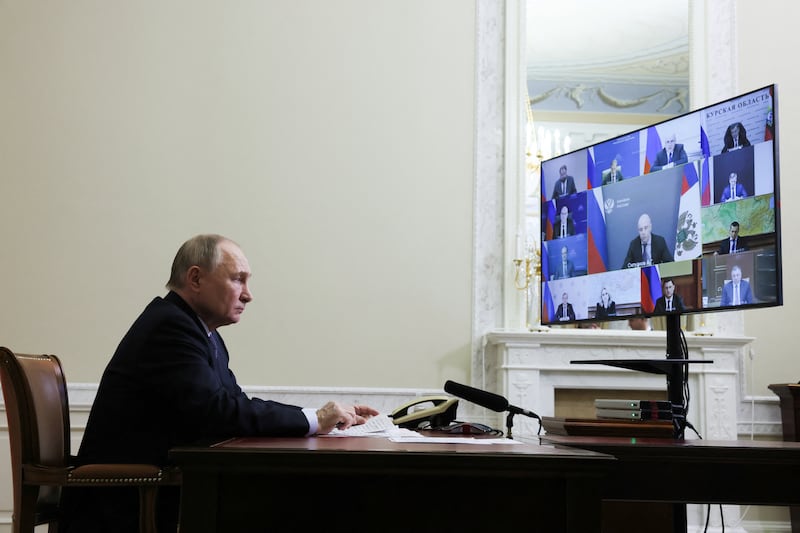If Russian officials slept on the flight home from Saudi Arabia after 4½ hours of talks with US counterparts on Tuesday, they may have woken up in Moscow wondering whether it had all been a strange and beautiful dream.
Gone, in a flash, was the diplomatic isolation imposed by western powers after the Kremlin launched its all-out invasion of pro-western Ukraine three years ago, and here was new US secretary of state Marco Rubio talking up “incredible opportunities” for US-Russia co-operation if the war could be brought to an end.
For further confirmation of the new reality, the Russians could watch US president Donald Trump on Tuesday night chiding Ukraine over a war that he said it “should never have started” and that any “half-baked negotiator” could have ended years ago.
In public, Moscow’s vastly experienced lead negotiators – foreign minister Sergei Lavrov and Kremlin foreign policy aide Yuri Ushakov – expressed only quiet satisfaction and guarded optimism for the rebuilding of ties with Washington, but the wider reaction to Trump’s overtures from Russian politicians and media has been euphoric.
RM Block
In just the last week, Trump and his senior officials have delivered public rebukes to Kyiv that could have come from a Kremlin checklist: Ukraine should not expect the return of all occupied territory, Nato membership or US peacekeepers as part of any peace deal, and it should hold elections urgently to remove supposed doubts over the legitimacy of its president, Volodymyr Zelenskiy.
Trump has not made a single public demand of the Kremlin, and his return to the White House could save the regime of Russian president Vladimir Putin from the mounting social and economic price of waging Europe’s biggest war in 80 years.

Russia’s sheer size helped it offset the collapse in trade with the West by selling more energy and other raw materials to the east and south – primarily to China and India – and importing sanctioned goods via Asian and Caucasus countries.
Vital oil and other exports have been maintained through Russia’s creation of a “shadow fleet” of hundreds of ageing tankers that are not insured by western firms and try to avoid western ports, largely inuring them to sanctions.
At the same time, a flood of military spending, which now accounts for more than a third of the national budget, has benefited Russian industry and poor communities across the country, where signing-on fees and wages for soldiers – as well as compensation for relatives of troops killed in Ukraine – vastly exceed anything what was on offer in peacetime.
The cost to Russia is rising rapidly, however, which makes Trump’s pursuit of a quick end to the war – apparently without much regard to the needs of Ukraine – such a godsend to the Putin regime.
More than a million, mostly young, people are thought to have fled Russia since 2022, and hundreds of thousands have been killed and injured in Ukraine, driving unemployment down towards two per cent and causing wages to spiral.
That has helped fuel a surge in inflation to about 10 per cent – and higher for many household staples – which the central bank in Moscow has tried to tame by raising its benchmark interest rate to a record 21 per cent.
To cover its budget deficit and prop up the ailing rouble, Russia has dipped ever deeper into its national wealth fund, where liquid assets have fallen by about two thirds since the start of the war to stand at about €36 billion now.
Putin hails solid gross domestic product (GDP) figures as proof of Russia’s power and the failure of western sanctions, but analysts say last year’s official estimate of 4.1 per cent growth hides big structural problems.
“When the government buys, say, a billion dollars’ worth of tanks, that’s addition to GDP of a billion dollars. Now, these tanks are burnt in Ukrainian fields ... It’s actually equivalent to the government just printing this billion dollars and handing it over to those people who work in the tank factory or their shareholders without producing anything,” Sergei Guriev, the dean of London Business School, said this week.
“So on paper, it looks like Russia is actually producing a lot of GDP, but a lot of those GDP are soldiers who are killed in Ukraine or wounded in Ukraine with their families getting cash, or weapons producers,” he told a Financial Times podcast.
The US could impose much more economic pain on the Kremlin to help Ukraine secure a fair peace deal, by working to bring down world oil prices or tightening implementation of existing sanctions on Russian energy.
Instead of using that leverage, however, US and Russian officials in Riyadh discussed possible joint energy projects in the Arctic – just the kind of grandiose scheme that would catch Trump’s eye.
The man leading the economic strand of talks for Moscow is US-educated ex-banker Kirill Dmitriev, the head of Russia’s state-run direct investment fund, who claimed US firms that had left his country because of the war had lost $300 billion (€278 billion).
On Wednesday, Dmitriev said he expected “a number of US companies to return to the Russian market as early as the second quarter of the year”.














